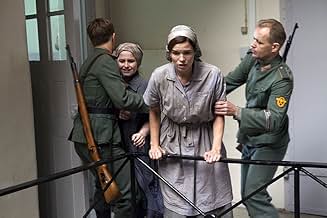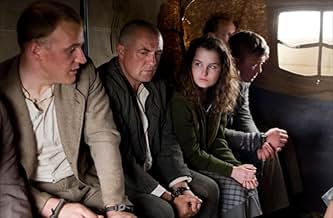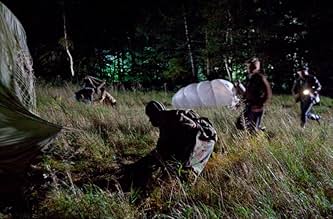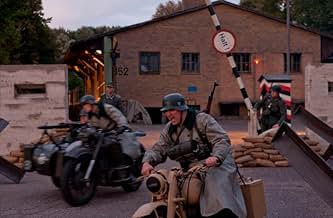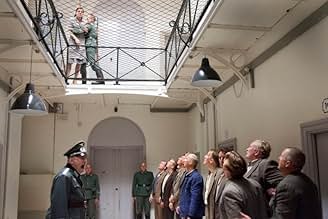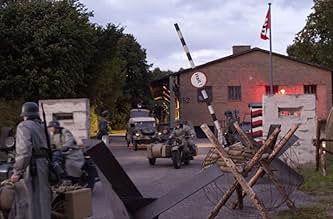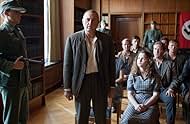CALIFICACIÓN DE IMDb
6.6/10
3.2 k
TU CALIFICACIÓN
La historia real de la familia Fiil, una familia de posaderos que, durante la ocupación nazi de Dinamarca, se alzaron en armas contra los ocupantes alemanes, pero en la lucha por la libertad... Leer todoLa historia real de la familia Fiil, una familia de posaderos que, durante la ocupación nazi de Dinamarca, se alzaron en armas contra los ocupantes alemanes, pero en la lucha por la libertad, algunos deben morir para que otros vivan.La historia real de la familia Fiil, una familia de posaderos que, durante la ocupación nazi de Dinamarca, se alzaron en armas contra los ocupantes alemanes, pero en la lucha por la libertad, algunos deben morir para que otros vivan.
- Premios
- 4 premios ganados y 5 nominaciones en total
Janus Kim Elsig
- Henning Andersen
- (as Janus Elsig)
Niels Lund Boesen
- Niels Kjær
- (as Niels Boesen)
Jakob Svarre Juhl
- Jens Stenz
- (as Jakob Svarre)
- Dirección
- Guionistas
- Todo el elenco y el equipo
- Producción, taquilla y más en IMDbPro
Argumento
¿Sabías que…?
- TriviaBased on a true story of a resistance group in Nazi occupied Denmark during World War II.
- ErroresIn the opening scenes the women are preparing meals in the kitchen while the men are playing cards. Both places the radios were switched on and you immediately hear the transmission of the speech of the Prime Minister. Before the invention of the transistor the components in a radio would need some ten seconds before they were warm enough to work properly and make the transmission work.
- ConexionesFeatured in Hvidsten Gruppen: Hvidsten Gruppen - De sidste vidner (2012)
Opinión destacada
1. Horrible dialogue. The characters explicitly state their occupations ('I attend the Agricultural College, not a house holding school', 'What's it like being a veterinarian?'). Not a single Danish actor talks like people did in the 1940's, i.e. they keep addressing strangers with the familiar 'du' {tu}, not the formal 'De' {vous}. – The dialogue is forced and full of anachronisms. I got the sensation of watching a bad written school play.
2. No one seems to be affected by the shortage of household goods. During the Nazi occupation, they drink what appears to be regular coffee and carbonated beverages. In fact, there doesn't seem to be a shortage of anything–except German soldiers in the first 45 minutes or so of the movie. What kind of occupation is this? Where are the miserable living conditions of wartime? 3. The resistance people are all way too chatty and amateurish. Everyone in the area knows who's in the resistance, even the kids know. What about a little secrecy? During the nightly activities, they can't get any work done without chatting and small talking. But that's not all, of course, they're also smoking. Even a lit matchstick can be seen from far away! Given the fact, however, that there're almost no Germans in the first part of the movie, why take precautions? No need for stealth operations. – I get it, the resistance members are just ordinary people risking their lives, but why depict them as being utter morons? It's quite insulting, actually.
4. Ridiculous scenes. One scene in particular comes to mind: A quiet, serious man walks into the tavern, wearing trench coat and fedora hat–the whole secret agent or private detective look. But all seriousness is blown away when he claims to be from The National museum of Denmark, looking for some good locations to perform archaeological excavations. – At this point I just laughed out loud. It's such a stupid and funny scene. Again, why depict the characters as idiots? It's not a comedy; at least I don't think it is.
In conclusion, this movie would make a very funny lampoon, if someone cut it down to a 20 minutes short. Nothing but the ridiculous scenes is worth watching, so a shortened version would be highly appreciated.
Thanks to Anne-Grethe Bjarup Riis–and everyone else involved with this uninspiring movie–for ridiculing some brave people who died for a noble cause. May they rest in peace.
One question remains unanswered: Did anyone involved with the production know anything about occupied Denmark in the 1940's? Anything at all?
2. No one seems to be affected by the shortage of household goods. During the Nazi occupation, they drink what appears to be regular coffee and carbonated beverages. In fact, there doesn't seem to be a shortage of anything–except German soldiers in the first 45 minutes or so of the movie. What kind of occupation is this? Where are the miserable living conditions of wartime? 3. The resistance people are all way too chatty and amateurish. Everyone in the area knows who's in the resistance, even the kids know. What about a little secrecy? During the nightly activities, they can't get any work done without chatting and small talking. But that's not all, of course, they're also smoking. Even a lit matchstick can be seen from far away! Given the fact, however, that there're almost no Germans in the first part of the movie, why take precautions? No need for stealth operations. – I get it, the resistance members are just ordinary people risking their lives, but why depict them as being utter morons? It's quite insulting, actually.
4. Ridiculous scenes. One scene in particular comes to mind: A quiet, serious man walks into the tavern, wearing trench coat and fedora hat–the whole secret agent or private detective look. But all seriousness is blown away when he claims to be from The National museum of Denmark, looking for some good locations to perform archaeological excavations. – At this point I just laughed out loud. It's such a stupid and funny scene. Again, why depict the characters as idiots? It's not a comedy; at least I don't think it is.
In conclusion, this movie would make a very funny lampoon, if someone cut it down to a 20 minutes short. Nothing but the ridiculous scenes is worth watching, so a shortened version would be highly appreciated.
Thanks to Anne-Grethe Bjarup Riis–and everyone else involved with this uninspiring movie–for ridiculing some brave people who died for a noble cause. May they rest in peace.
One question remains unanswered: Did anyone involved with the production know anything about occupied Denmark in the 1940's? Anything at all?
- aftenfilosof
- 19 ago 2012
- Enlace permanente
Selecciones populares
Inicia sesión para calificar y agrega a la lista de videos para obtener recomendaciones personalizadas
- How long is This Life?Con tecnología de Alexa
Detalles
Taquilla
- Total a nivel mundial
- USD 9,388,513
- Tiempo de ejecución2 horas 2 minutos
- Color
- Relación de aspecto
- 2.35 : 1
Contribuir a esta página
Sugiere una edición o agrega el contenido que falta

Principales brechas de datos
By what name was Hvidsten gruppen (2012) officially released in Canada in English?
Responda
